
Cabannes is a lunar impact crater that lies in the southern hemisphere on the far side of the Moon. The rim has been worn by subsequent impacts, with a smaller crater overlying the southern rim. However the formation has not been significantly reshaped by nearby craters.

Deseilligny is a small lunar impact crater in the southern part of the Mare Serenitatis. It was named after French selenographer Jules Deseilligny. It is located to the east-southeast of the crater Bessel. Deseilligny is a bowl-shaped crater with a low rim. It is otherwise undistinguished.

Fahrenheit is a tiny lunar impact crater located in the southeast part of the Mare Crisium. This area of the surface is nearly devoid of impact features of interest. To the east are the Dorsa Harker wrinkle ridges, and beyond them is Promontorium Agarum at the edge of the mare. The landing site of the Soviet Luna 24 probe is located about 15 kilometers to the southeast.

Artemʹev is a lunar impact crater that is located on the far side of the Moon. The rim of this crater has been modified by subsequent impacts in the vicinity, with an inward bulge along the southwest edge and a worn impact lying across the north rim. The satellite crater Artemʹev G is partly overlain by the southeast rim of Artemʹev. The crater interior is relatively flat, and marked only by tiny craterlets.
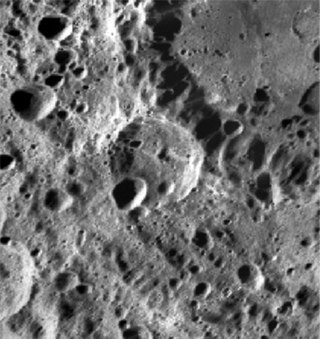
Belyaev is a lunar impact crater that is attached to the outer edge of the Mare Moscoviense, on the far side of the Moon. It is a worn formation with a small crater pair overlaying the southern rim, and several smaller craters across the relatively irregular interior.

Brisbane is a lunar impact crater that is located in the southeastern part of the Moon, to the south of the crater Peirescius. To the northwest lie the craters Vega and Reimarus, and farther to the east is the walled plain Lyot. Due to its proximity to the limb, foreshortening of this crater causes it to appear somewhat elliptical in shape, even though it is actually circular.

Liouville is a small lunar impact crater that is located near the eastern limb of the Moon. It was named after French mathematician Joseph Liouville. It lies to the southeast of the larger crater Dubyago, and was previously designated Dubyago S before being given a name by the IAU.

Respighi is a small lunar impact crater that is located to the southeast of the crater Dubyago, near the eastern limb of the Moon. To the east is the comparably sized Liouville.

Stewart is a small lunar impact crater that lies to the northeast of the Mare Spumans, a small lunar mare near the eastern limb of the Moon. It was named after American astrophysicist John Quincy Stewart. It is located to the north of the crater Pomortsev, and to the southwest of the lava-flooded Dubyago. Stewart was previously designated Dubyago Q before being named by the IAU. This is a circular crater with a low outer rim and a level, featureless interior floor.
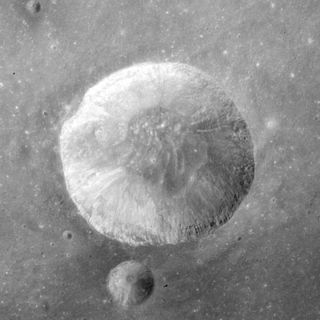
Carmichael is a lunar impact crater that is located along the eastern edge of the Sinus Amoris, in the northeastern quadrant of the Moon's near side. Its diameter is 20 km. It was named after American psychologist Leonard Carmichael. It lies within a couple of crater diameters south-southwest of the smaller crater Hill. Further to the east-northeast is the prominent crater Macrobius. Carmichael was designated Macrobius A before being given its current name by the IAU.
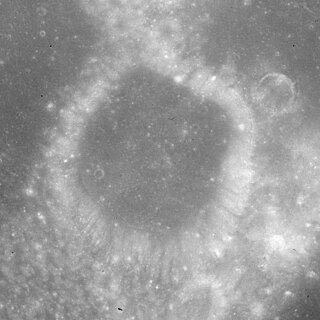
Pomortsev is a small lunar impact crater that is located in the eastern part of the Moon's near side. It was named after Russian rocketry scientist Mikhail Pomortsev. It lies on the eastern edge of Mare Spumans, to the southwest of the crater Dubyago. This formation was previously designated Dubyago P. One crater diameter to the north is the smaller Stewart.
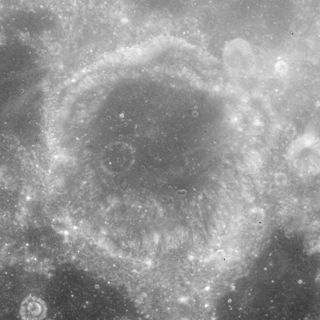
Dubyago is a lunar impact crater that lies in the eastern limb of the Moon. It was named after Russian astronomers Dmitry Dubyago and Alexander Dubyago. It appears significantly foreshortened when viewed from the Earth. It lies along the southern shore of the Mare Undarum, to the southeast of the crater Firmicus.

Elmer is a small lunar impact crater that is located to the south of Mare Smythii, near the eastern limb of the Moon. This crater is seen at a highly oblique angle from Earth, and the visibility is affected by libration. Elmer lies southwest of the crater Kreiken, and east-southeast of the larger Dale. This is a circular, bowl-shaped crater with an interior floor that occupies about half the total diameter.

Courtney is a tiny lunar impact crater on the Mare Imbrium, a lunar mare in the northwest quadrant of the Moon. It lies about two crater diameters to the northwest of Euler, in an otherwise isolated stretch of the mare. The dark surface in this region is marked by Euler's ray material. The name is an English male name.

Charlier is a lunar impact crater located on the far side of the Moon. To its south-southeast lies the larger crater Kovalevskaya, while Perrine is situated to the northeast.

Chernyshev is a lunar impact crater that is located in the northern part of the Moon's far side. It lies to the northeast of the crater Chandler, and to the southeast of the walled plain D'Alembert.

Dante is a lunar impact crater that is located on the far side of the Moon. It lies in the northern hemisphere exactly opposite the prime meridian facing the Earth. The nearest craters of note are Larmor to the north and Morse to the southeast. To the southwest is the oddly shaped Buys-Ballot.

Emden is a lunar impact crater that is located in the northern hemisphere on the far side of the Moon. It is named after Jacob Robert Emden (1862-1940).
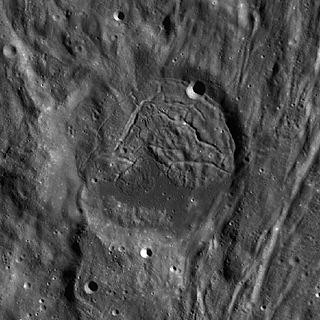
Fényi is a small lunar crater on the far side of the Moon. It lies near the southern edge of the huge, braided skirt of ejecta that surrounds the Orientale impact Basin to the north. Less than two crater diameters to the southwest is the much larger crater Mendel.

Fesenkov is a lunar impact crater on the far side of the Moon. It is located to the east-southeast of the prominent crater Tsiolkovskiy, and less than a crater diameter to the north of Stark.






















